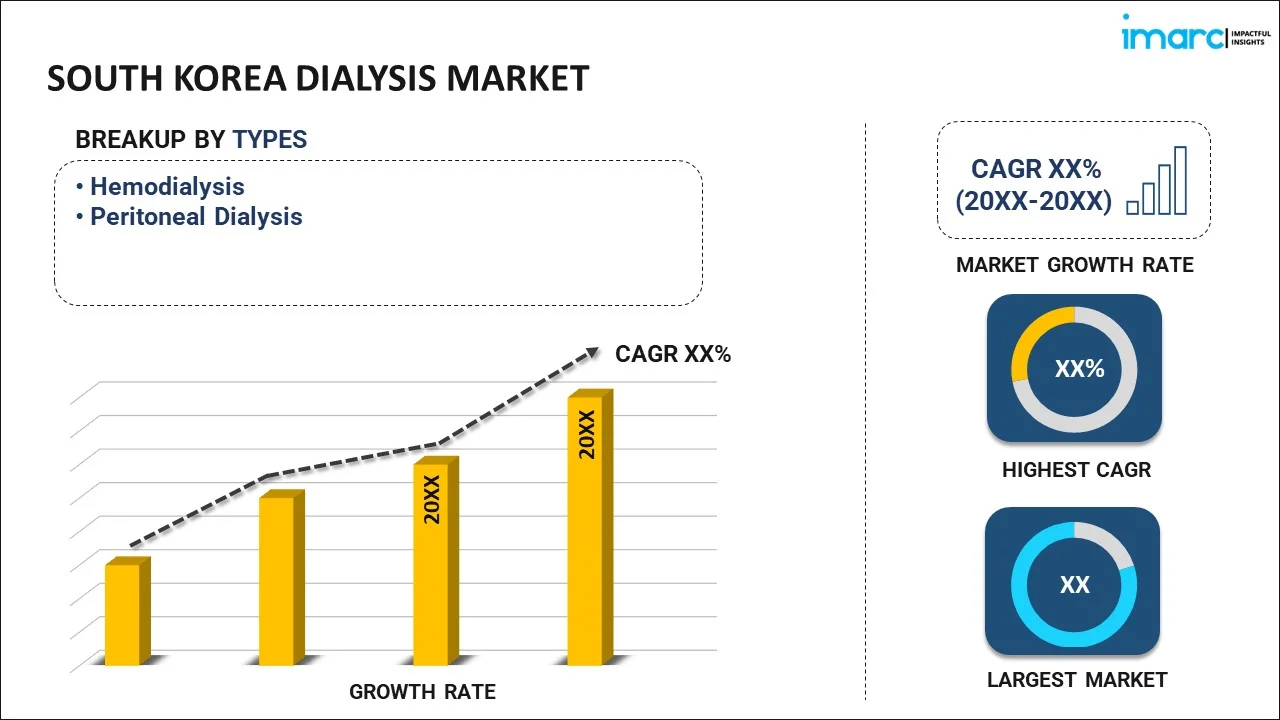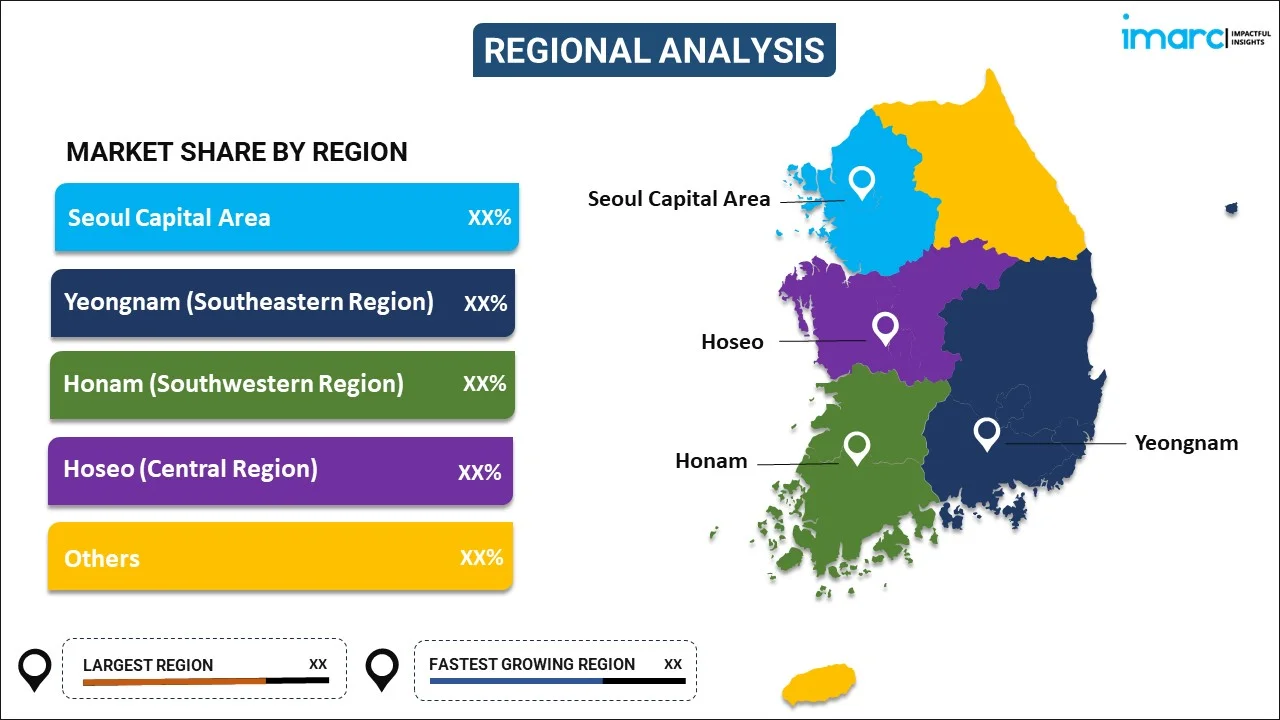
South Korea Dialysis Market Report by Type (Hemodialysis, Peritoneal Dialysis), Product and Services (Services, Equipment, Consumables, Dialysis Drugs), End User (In-center Dialysis, Home Dialysis), and Region 2025-2033
Market Overview:
South Korea dialysis market size reached USD 2,303.2 Million in 2024. Looking forward, IMARC Group expects the market to reach USD 3,600.1 Million by 2033, exhibiting a growth rate (CAGR) of 5.09% during 2025-2033. The growing utilization of data analytics and artificial intelligence (AI) to optimize dialysis treatment protocols, rising prevalence of chronic kidney diseases due to lifestyle-related factors, and increasing investments by private healthcare providers and organizations represent some of the key factors driving the market.
|
Report Attribute
|
Key Statistics
|
|---|---|
|
Base Year
|
2024
|
|
Forecast Years
|
2025-2033
|
|
Historical Years
|
2019-2024
|
| Market Size in 2024 | USD 2,303.2 Million |
| Market Forecast in 2033 | USD 3,600.1 Million |
| Market Growth Rate 2025-2033 | 5.09% |
Dialysis is a medical procedure functioning as a synthetic replacement for impaired kidney function. It is manufactured through sophisticated technology to ensure safety and efficacy, with machines designed to regulate the exchange of substances and monitor vital parameters. It can be primarily categorized into two types, including hemodialysis, where blood is filtered outside the body using a machine, and peritoneal dialysis, which uses the lining of the abdomen as a natural filter. It serves as a critical intervention for patients with renal failure, effectively replacing the key functions of the kidneys. It helps to retain fluid and electrolyte balance, remove toxins, and significantly improve the quality of life for individuals with severe kidney issues. It benefits patients by reducing the symptoms of kidney failure, such as fatigue, swelling, and nausea, and it can be a bridge to kidney transplantation. It is employed in acute kidney injuries and managing certain cases of poisoning.
South Korea Dialysis Market Trends:
At present, the rising prevalence of chronic kidney diseases (CKD) due to lifestyle-related factors, such as unhealthy diets, sedentary lifestyles, and increasing conditions like hypertension and diabetes, represents one of the vital factors impelling the growth of the market in South Korea. The growing geriatric population, which is more susceptible to the risk of CKD, is also driving the demand for dialysis services to manage the kidney health. Additionally, the increasing utilization of data analytics and artificial intelligence (AI) to optimize dialysis treatment protocols is supporting the market growth. These AI algorithms can help predict complications, recommend personalized treatment adjustments, and identify trends by analyzing vast amounts of patient data, which improves long-term outcomes. Besides this, the growing support by the governing body in terms of healthcare spending and policies geared towards chronic disease management, including subsidies for dialysis, is positively influencing the market. Moreover, rising investments by private healthcare providers and organizations in the establishment of state-of-the-art dialysis centers equipped with the latest technology are contributing to the market growth in the country. These facilities often offer a higher level of comfort and personalized care. In addition, the increasing popularity of different home dialysis options among patients who prefer a more flexible treatment schedule in the comfort of their homes is bolstering the market growth. This not only provides convenience to patients but also reduces the burden on healthcare facilities. Furthermore, the growing emphasis on research and development (R&D) in the healthcare sector is resulting in novel dialysis technologies, such as wearable devices for continuous monitoring and more efficient filtration systems.
South Korea Dialysis Market Segmentation:
IMARC Group provides an analysis of the key trends in each segment of the market, along with forecasts at the country level for 2025-2033. Our report has categorized the market based on type, product and services, and end user.
Type Insights:

- Hemodialysis
- Conventional Hemodialysis
- Short Daily Hemodialysis
- Nocturnal Hemodialysis
- Peritoneal Dialysis
- Continuous Ambulatory Peritoneal Dialysis (CAPD)
- Automated Peritoneal Dialysis (APD)
The report has provided a detailed breakup and analysis of the market based on the type. This includes hemodialysis [(conventional hemodialysis, short daily hemodialysis, and nocturnal hemodialysis) and peritoneal dialysis (continuous ambulatory peritoneal dialysis (CAPD) and automated peritoneal dialysis (APD)].
Product and Services Insights:
- Services
- Equipment
- Dialysis Machines
- Water Treatment Systems
- Others
- Consumables
- Dialyzers
- Catheters
- Others
- Dialysis Drugs
A detailed breakup and analysis of the market based on the product and services have also been provided in the report. This includes services, equipment (dialysis machines, water treatment systems, and others), consumables (dialyzers, catheters, and others), and dialysis drugs.
End User Insights:
- In-center Dialysis
- Home Dialysis
The report has provided a detailed breakup and analysis of the market based on the end user. This includes in-center dialysis and home dialysis.
Regional Insights:

- Seoul Capital Area
- Yeongnam (Southeastern Region)
- Honam (Southwestern Region)
- Hoseo (Central Region)
- Others
The report has also provided a comprehensive analysis of all the major regional markets, which include Seoul Capital Area, Yeongnam (Southeastern Region), Honam (Southwestern Region), Hoseo (Central Region) and Others.
Competitive Landscape:
The market research report has also provided a comprehensive analysis of the competitive landscape. Competitive analysis such as market structure, key player positioning, top winning strategies, competitive dashboard, and company evaluation quadrant has been covered in the report. Also, detailed profiles of all major companies have been provided.
South Korea Dialysis Market Report Coverage:
| Report Features | Details |
|---|---|
| Base Year of the Analysis | 2024 |
| Historical Period | 2019-2024 |
| Forecast Period | 2025-2033 |
| Units | Million USD |
| Scope of the Report | Exploration of Historical Trends and Market Outlook, Industry Catalysts and Challenges, Segment-Wise Historical and Future Market Assessment:
|
| Types Covered |
|
| Product and Services Covered |
|
| End Users Covered | In-center Dialysis, Home Dialysis |
| Regions Covered | Seoul Capital Area, Yeongnam (Southeastern Region), Honam (Southwestern Region), Hoseo (Central Region), Others |
| Customization Scope | 10% Free Customization |
| Post-Sale Analyst Support | 10-12 Weeks |
| Delivery Format | PDF and Excel through Email (We can also provide the editable version of the report in PPT/Word format on special request) |
Key Questions Answered in This Report:
- How has the South Korea dialysis market performed so far and how will it perform in the coming years?
- What has been the impact of COVID-19 on the South Korea dialysis market?
- What is the breakup of the South Korea dialysis market on the basis of type?
- What is the breakup of the South Korea dialysis market on the basis of product and services?
- What is the breakup of the South Korea dialysis market on the basis of end user?
- What are the various stages in the value chain of the South Korea dialysis market?
- What are the key driving factors and challenges in the South Korea dialysis?
- What is the structure of the South Korea dialysis market and who are the key players?
- What is the degree of competition in the South Korea dialysis market?
Key Benefits for Stakeholders:
- IMARC’s industry report offers a comprehensive quantitative analysis of various market segments, historical and current market trends, market forecasts, and dynamics of the South Korea dialysis market from 2019-2033.
- The research report provides the latest information on the market drivers, challenges, and opportunities in the South Korea dialysis market.
- Porter's five forces analysis assist stakeholders in assessing the impact of new entrants, competitive rivalry, supplier power, buyer power, and the threat of substitution. It helps stakeholders to analyze the level of competition within the South Korea dialysis industry and its attractiveness.
- Competitive landscape allows stakeholders to understand their competitive environment and provides an insight into the current positions of key players in the market.
Need more help?
- Speak to our experienced analysts for insights on the current market scenarios.
- Include additional segments and countries to customize the report as per your requirement.
- Gain an unparalleled competitive advantage in your domain by understanding how to utilize the report and positively impacting your operations and revenue.
- For further assistance, please connect with our analysts.
 Request Customization
Request Customization
 Speak to an Analyst
Speak to an Analyst
 Request Brochure
Request Brochure
 Inquire Before Buying
Inquire Before Buying




.webp)




.webp)












